Indicators on Google Analytics Event Tracking You Should Know
Table of ContentsAbout Google Analytics Event TrackingGoogle Analytics Event Tracking Fundamentals ExplainedThe smart Trick of Google Analytics Event Tracking That Nobody is Talking AboutTop Guidelines Of Google Analytics Event TrackingThe 10-Minute Rule for Google Analytics Event TrackingExcitement About Google Analytics Event Tracking

If you're going to set up occasion monitoring by hand, then you're mosting likely to have to include some additional code to the aspects you wish to collect data from. The code you're going to collaborate with will look something like this: There are 4 components within that code fragment that you're going to require to define on your own: event, Group, occasion, Action, occasion, Label and event, Value.
As you can see, 2 of these are called for (classification and activity) while tag and value are optional. All of it relies on the kind of information you want communicated back to Google Analytics when a user clicks on the specified element (Google Analytics Event Tracking). It will be much easier to define these parts if you analyse your web site and decide which elements/actions you want to track
Not known Incorrect Statements About Google Analytics Event Tracking
Now, you'll be asked to define the and and you'll intend to pick from the drop-down menu that appears when you click. This will certainly raise the very same event monitoring components we considered earlier, which you'll need to submit. As soon as you've defined these, you can move to the second box and choose the trigger that will certainly fire your tag.
On the next display, you'll also have an area for naming your trigger and, if you click on package, you'll see a list of the different triggers you can pick. In this situation, we wish to choose and then pick the option below. After that you'll establish the trigger to only fire when an aspect is clicked with an URL that consists of the.
Every website talks. Before information analytics, we could not listen to the voices of our sites. Yet exactly how do you understand what your site is saying? Easy - Occasion monitoring! Occasion monitoring offers you a photo of exactly how customers engage with your web site and business (Google Analytics Event Tracking). Do you need to know even more? Check out on as we check out every little thing you need to understand, including what it is, why you should track events, exactly how to take care of occasions information, and various other appropriate FAQs check this site out you may have.
Google Analytics Event Tracking Can Be Fun For Anyone
You can switch over between your occasion groups, actions, and tags in the Top Occasions report. The Event Pages record presents the pages where occasions are triggered.
It reveals find you the path they take as they relocate from one occasion to the following and helps you to identify which content involves your target market the a lot of. Events in Google Analytics have 4 main aspects. They are additionally a component of the event tracking code. Google Analytics utilizes these codes to track customer interactions and group them into occasion records.
A list of the specifications you can track on your web site is on the. After examining all required areas, you can click "X" to shut the home window and return to the Introduction menu on the.
How Google Analytics Event Tracking can Save You Time, Stress, and Money.

If you have not done so, you may require to establish up a variable in the Google Analytics Settings box. After this, enter your GA monitoring ID in the Tracking ID field.
Your ID will certainly get on top of the screen. To do this, adhere to the following series of actions: After configuring the fields, select the "Triggering" section. When configuring your new trigger, click the "+" button, after that the "pencil" button, after that pick your trigger type. Label your trigger and define the conditions that bring about trigger shooting.
An Unbiased View of Google Analytics Event Tracking
When it familiarizes which sections and aspects are directing customers with your conversion funnel, you still won't understand. So, Visit Your URL without event monitoring, GA reports will only count check outs as single-page sessions, even if individuals invest a great deal of time on one web page and involve with it substantially (and a bounce).
Exactly how does event monitoring achieve this?Single-web page sessions understood as bounces start and end on the same web page. Without occasion tracking, GA will identify a user's browse through as a bounce if they don't navigate to an additional web page, despite just how they interact with it. A video-rich page can have a greater bounce price if occasions are not tracked.
The smart Trick of Google Analytics Event Tracking That Nobody is Talking About
Nonetheless, for GA to take event hits right into account when measuring bounce prices, you must choose "Non-interaction event" as "False" throughout the GTM arrangement. Setting "occasion goals" with occasion activity is an excellent method to monitor individual activities you value highly, such as brand-new lead submissions or clicks on a contact us to action.